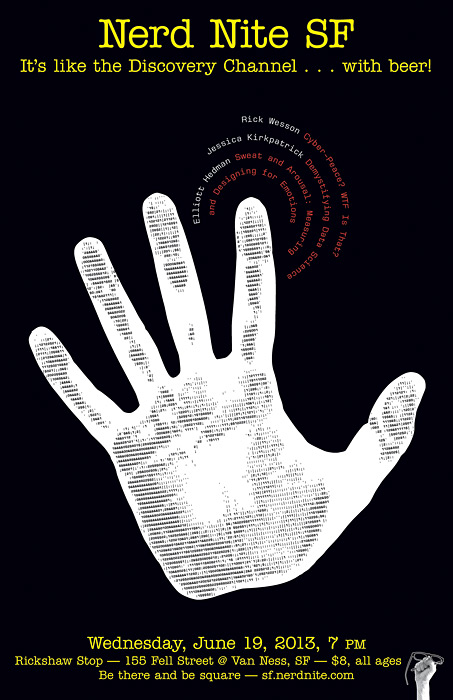 SOLD OUT!
SOLD OUT!
Instead, check out “Science, Neat” on 6/18 or our sister event in Oakland, “Nerd Nite East Bay”, on 6/24.
Wednesday, 6/19
Doors at 7 pm, show at 8
Rickshaw Stop, 155 Fell St @Van Ness
$8 (advance tix here – SOLD OUT)
All ages
Facebook event
“Nerd Nite SF: Making the Intangible Tangible Since 2010!” Or something like that. And this month in particular. But don’t be put off by the abstractnesses outlined in these talks’ abstracts. (Or by our beginning sentences with conjunctions.) Come, grasp a cold alcoholic beverage while grasping the seemingly ungraspable: Make code, not war! Mine, define, recombine data! Let your sweat, tears, and pounding pulse be your guides! Be there and be square!
—————————-
“Cyber-Peace? WTF Is That?” by Rick Wesson
After spending a few years fabricating digital warheads Rick Wesson is exploring the flip side of the torpedo: the concept of “peace” in cyberspace. What can cyber-peace be amid the escalating tensions in the virtual world? With the current threats to our privacy and the open commons being facilitated by the NSA, their for-profit contractors, and your favorite Silicon Valley “cyber-crime fighters,” it behooves us all to join a different kind of anti-war movement. Make code, not war!
Rick is CEO of network security company Support Intelligence and protagonist of Worm: The First Digital World War, among other impressive acronymic involvements (ICANN, DNSSEC). When not growing organic veggies, building shotspotters, herding sheep, and being a patriot, he enjoys coding out of a 40’ shipping container.
—————————-
“Demystifying Data Science” by Jessica Kirkpatrick
Data. There’s a heck of a lot of it floating around out there. But how do we discover it, rein it in, interpret it, and make it findable, understandable, and useful? Well, it helps to be a statistician, computer scientist, firefighter, treasure hunter and therapist rolled into one–or you could become what has been called the sexiest job of the 21st century: data scientist! So, what exactly is data science? How is all this data changing business? And how does one enter this hot new field?
Jessica is an astrophysicist-turned-data scientist. After receiving her PhD from UC Berkeley in 2012, she joined the data science team at the social network Yammer.
—————————-
“Sweat and Arousal: Measuring and Designing for Emotions” by Elliott Hedman
A kid jumping into a ball pit. A shopper navigating the supermarket. An audience experiencing the Blue Man Group. You grabbing a beer and watching this presentation. In all these activities, emotions physically change the body and mind. Why does this matter? How can we better design our world to respond to these fluctuating, subconscious physical responses? By the end of this talk, you will know how to have a better colonoscopy, why bridges are a great place to find a date, and how to build a better emotional experience.
Elliott arrives from the MIT Media Lab/IDEO where his PhD focuses on making emotions tangible by measuring subconscious, physical responses. He dreams of a day when milk will be placed at the front of the store.
—————————-
DJ Alpha Bravo mans the decks, spinning vinyl and tweeting along to the presentations’ themes. Find out what you’re listening to by following @djalphabravo.
Upstairs food by the legendary Grilled Cheez Guy!
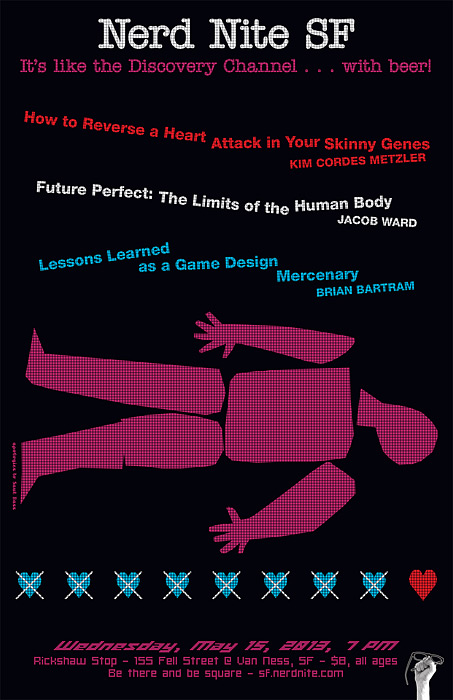 Wednesday, 5/15
Wednesday, 5/15
Doors at 7 pm, show at 8
Rickshaw Stop, 155 Fell St @Van Ness
$8 (advance tix available here)
All ages
SOLD OUT!
No tickets at the door. Hope to see you at next month’s Nerd Nite SF or at Nerd Nite East Bay on 5/27!
Facebook event
We’re a fragile species, what with our heart disease and video game addictions and, well, fragile-ness. But fear not: Nerds are here to help you make sense of it all, with alcoholic drinks and righteous tunes lubricating the way. So, come, turn on the right genes, understand your bodies’ limits, and get the straight dope on what it’s like to design video games. Be there and be square!
——————–
“Backmasking 3 Billion Beats: How to Reverse a Heart Attack in Your Skinny Genes” by Kim Cordes Metzler
The heart beats more than 3 billion times during a lifetime, but for an estimated 25% of us, heart disease can cut those beats short. Scientists and doctors are trying to reverse the mechanisms of disease so we can get some of those beats back. This talk will provide a glimpse of how cutting-edge research is allowing us to turn on 3 genes, our “skinny genes,” to backmask, as it were, the music of our hearts.
Kim earned her Ph.D. in genetics and development at the University of Texas Southwestern Medical School at Dallas in 2009. After completing her postdoc at UCSF and the Gladstone Institute of Cardiovascular Disease, she continues as a staff scientist at Gladstone creating stem cells to study heart disease.
——————–
“Future Perfect: The Limits of the Human Body” by Jacob Ward
Our frail vessels have an alarming tendency to burst, burn and break, and yet we constantly travel to dangerous places, dive under the ocean, fly, drive, drink alcohol, and otherwise do things that our bodies are wholly unqualified to handle. We’ll discuss the science of human limitation, and what fundamental technologies make it possible for us not to suffocate, freeze, catch on fire, or otherwise die the thousand deaths that our unbelievably dangerous lives whisk us past each day.
Jake is editor-in-chief of Popular Science, the world’s largest science and technology magazine. He’s written for The New Yorker and Wired, and has hosted television shows for Discovery, PBS and National Geographic. He splits his time between New York and California.
——————–
“Lessons Learned as a Game Design Mercenary” by Brian Bartram
Necromorphs and Nazis! Stormtroopers and Scooby Doo! Transforming robots and simulated cities! DARPA and the Department of Homeland Security! What do these have in common? And why would any sane person make a career out of designing video games? The journey is long and fraught with peril, so heed my tales if you’ve ever wondered what it’s like to work in the trenches of video game development.
Brian is a video game designer who has seen tours of duty on games such as SimCity, Dead Space 2, Star Wars: The Old Republic, and The Saboteur. He has worked on simulation games, third-person action games, open-world games, MMORPGs, and first-person shooters for PC, consoles, and portable game systems.
——————–
DJ Alpha Bravo mans the decks, spinning vinyl and tweeting along to the presentations’ themes. Find out what you’re listening to by following @djalphabravo.
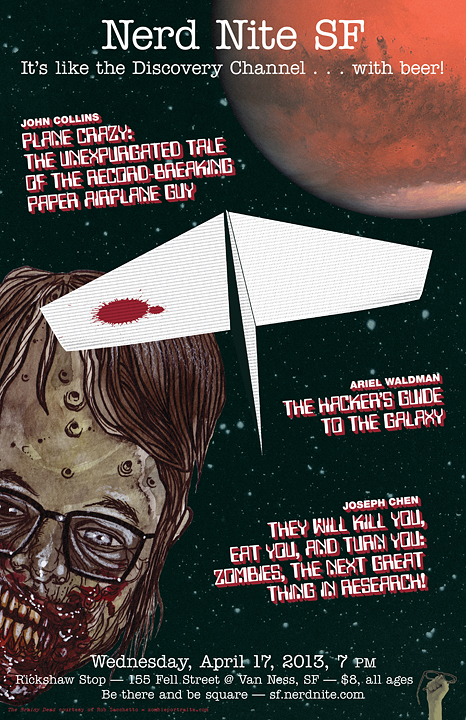
The Brainy Dead courtesy of Rob Sacchetto — zombieportraits.com
Wednesday, 4/17
Doors at 7 pm, show at 8
Rickshaw Stop, 155 Fell St @Van Ness
$8
All ages
Advance tix
Facebook event
Sorry to break it to you, but it seems the zombie apocalypse is kinda inevitable, so we’ll be learning about that. (Time to have a drink or three!) But before we all become the undead, won’t it be nice to learn how to make a few killer paper airplanes? Or maybe escape our zombified fate entirely by hacking our way off this planet? Come celebrate the cruelest month with drinks, music, and, oh yeah, learnin’! Be there and be square!
——————–
“Plane Crazy: The Unexpurgated Tale of the Record-Breaking Paper Airplane Guy” by John Collins
John Collins, a.k.a. The Paper Airplane Guy, smashed the Guinness world record for paper airplane distance in 2012. Along the way, NASA snubbed him, the previous world record holder tried to sabotage him, and people plied him with ideas both weird and wonderful. This paper-folding raconteur who has taught thousands of people to make paper airplanes will teach us, too. Wear your safety goggles if you don’t want the pointy end of a plane in yer eye!
John is the author of three published collections of paper airplanes: The Gliding Flight; Fantastic Flight; and The New World Champion Paper Airplane Book, published last month, which chronicles the record chase, the breakthrough plane, and 20 more great designs.
——————–
“They Will Kill You, Eat You, and Turn You: Zombies, the Next Great Thing in Research!” by Joseph Chen
Stem cell research is cool, but it will inevitably cause the Zombie Apocalypse. And what we’ll face won’t be the slow, decayed, shambling undead that are easy to dismember. Instead, we’ll get the fast, angry, genetically modified zombies without inhibitions or memories. They will want to eat your brains. They will kill you. They will infect you.
Joseph is a postdoc at UCSF, working primarily on HIV, and also a part of a team of researchers developing adult stem cells for therapeutic purposes. Previously, he worked for Merck and Schering Plough, where he developed treatment strategies for Alzheimer’s and Parkinson’s.
——————–
“The Hacker’s Guide to the Galaxy” by Ariel Waldman
Don’t panic: The next big science revolution isn’t just for asteroid miners. Just as science fiction has often shown the way to future inventions, hacking is now generating prototypes that will act as footholds for future explorations, discoveries, and epiphanies in science. Find out how you can actively explore the final frontier by getting excited and making things.
Ariel Waldman is the global instigator of Science Hack Day, a research affiliate at Institute for the Future, and the founder of Spacehack.org, a directory of ways to participate in space exploration. Recently Ariel was appointed as an NRC committee member of a congressional study on the future of human spaceflight.
——————–
DJ Alpha Bravo mans the decks, spinning vinyl and tweeting along to the presentations’ themes. Find out what you’re listening to by following @djalphabravo.
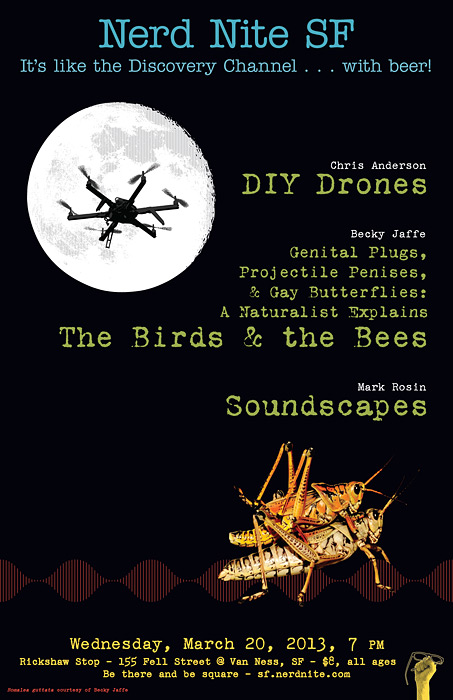
Romalea guttata courtesy of Becky Jaffe
SOLD OUT! This month’s event has completely sold out. There will not be tickets available at the door. Sorry!
It is a special Nerd Nite indeed that can guarantee to explore every definition of the word “drone!” From the pilotless aircrafts cooked up by amateur aerospace engineers, to the male bees and other creatures that engage in wacky sexcapades, to the humming of the universe itself, our speakers will promise not to drone on. So procure an alcoholic beverage and tune in to our nerdy frequency: Be there and be square!
Wednesday, 3/20
Doors at 7 pm, show at 8
Rickshaw Stop, 155 Fell St @Van Ness
$8
All ages
Advance tix – SOLD OUT
Facebook event info
———————
“DIY Drones” by Chris Anderson
What happens when you combine smartphone guts, open-source software, and toy planes and copters? Fully autonomous flying robots! Find out how a band of amateurs beat the aerospace industry to the future of aviation: small, cheap, and out of control.
Chris Anderson is the CEO of 3D Robotics and founder of DIY Drones, former editor-in-chief of Wired Magazine, and author of The Long Tail and Free, as well as the new Makers: The New Industrial Revolution.
———————
“Genital Plugs, Projectile Penises, and Gay Butterflies: A Naturalist Explains the Birds & the Bees” by Becky Jaffe
Birds do it, bees do it–even educated fleas do it. Let’s do it, let’s fall in lust as photographer and insect fetishist Becky Jaffe takes us on a romp through Mother Nature’s freaky side. Biophilia? This talk may well bring on a biorgasm!
A photographer, naturalist, and educator living in Oakland, Becky Jaffe (www.beckyjaffe.com) teaches high school biology and leads environmental science tours at UC Berkeley’s Botanical Garden.
———————
“Soundscapes” by Mark Rosin
We’ll explore acoustic life in sex, bass, and outer space, from bedroom antics to an audio tour of the Universe. It turns out space isn’t silent–if you know how to listen. Close your eyes and enjoy a slide show for your ears.
Mark Rosin is a UCLA physicist and member of Guerilla Science (https://guerillascience.co.uk/), who mix science with art, music, and play.
———————
DJ Alpha Bravo mans the decks, spinning vinyl and tweeting along to the presentations’ themes. Find out what you’re listening to by following @djalphabravo.
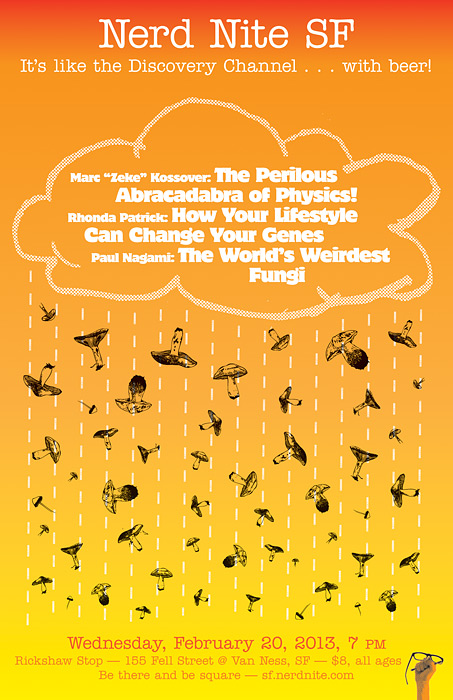 Step right up to the most amazing (drunkest), most thrilling (nerdiest), most awe-inspiring (wear safety goggles) show on Earth–or at least in SF on the third Wednesday of the month! The coolest science teacher will play ringmaster to a physics circus, a biochemist will prove you don’t have to jump through flaming hoops to change your genetic makeup, and a mycologist will entertain you with the clowns of the mushroom world. Be there and be square!
Step right up to the most amazing (drunkest), most thrilling (nerdiest), most awe-inspiring (wear safety goggles) show on Earth–or at least in SF on the third Wednesday of the month! The coolest science teacher will play ringmaster to a physics circus, a biochemist will prove you don’t have to jump through flaming hoops to change your genetic makeup, and a mycologist will entertain you with the clowns of the mushroom world. Be there and be square!
Wednesday, 2/20
Doors at 7 pm, show at 8
Rickshaw Stop, 155 Fell St @Van Ness
$8
All ages
Advance tickets
Facebook event
———————
“The Perilous Abracadabra of Physics!” by Marc “Zeke” Kossover & his Physics Circus
Physics demonstrations are like perfect magic shows: They have all the spectacle, but there are no tricks. The amazing world we live in actually works that way! These are the experiments that your physics teacher didn’t do because they were too dangerous, crazy, or weird. Come for the liquid nitrogen-spewing, glass-breaking spectacle, but leave understanding the science!
Marc “Zeke” Kossover was an Albert Einstein Distinguished Educator Fellow to the US government, where they listened to him from time to time. Along with performing at science events around the country, he is a mentor teacher with the Exploratorium and runs Sidewalk Science.
———————
“How Your Lifestyle Can Change Your Genes” by Rhonda Patrick
“It’s genetic–nothing I can do about it, right?” Wrong! If you have a family history of heart disease, diabetes, obesity, breast or prostate cancer, or Alzheimer’s disease, then you merely have a predisposition that can be prevented and even reversed. By changing your diet and lifestyle, you can reach into your DNA and turn genes on or off–and even pass these changes on to your offspring. Come learn the why and how of flipping your epigenetic switches!
Rhonda Patrick is passionate about disseminating health-related information to the public. Now a postdoc at the Bruce Ames (as in the Ames test!) Lab at CHORI, she earned a biochemistry degree from UCSD and a Ph.D. from the University of Tennessee Health Science Center.
———————
“The World’s Weirdest Fungi” by Paul Nagami
Join us as we root around and uncover the strangest, most unbelievable fungi on Earth, from the “Humongous Fungus” under Oregon (Armillaria solidipes) to the tiny Drewes’ Phallus (Phallus drewesii). Carnivorous fungi, brainwashed ants, and the Malaysian Spongebob fungus (Spongiforma squarepantsii) will also feature in this magnificent mycological expedition.
Paul Nagami has been hunting, identifying, and eating wild mushrooms since he was in fourth grade. He co-hosts the microscope table at the Mycological Society of San Francisco’s (www.MSSF.org) annual Fungus Fair.
———————
DJ Alpha Bravo mans the decks, spinning vinyl and tweeting along to the presentations’ themes. Find out what you’re listening to by following @djalphabravo.
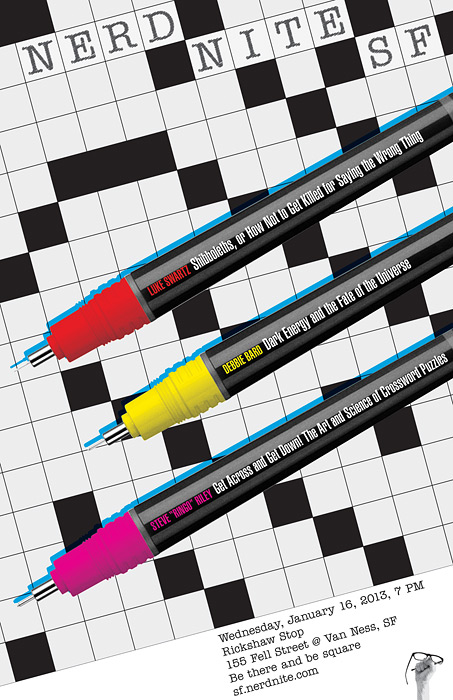 First, the good news: We have a coupla language nerds and a cosmologist coming to help you fulfill your resolution to drink more and learn more! Start sharpening your shibboleths and prove you belong; contemplate the mysteries of dark energy; and be reminded why Eero Saarinen is every crossword lover’s favorite designer. Scientist-cum-food-carter Grilled Cheese Guy‘ll be here, too, to feed our maws!
First, the good news: We have a coupla language nerds and a cosmologist coming to help you fulfill your resolution to drink more and learn more! Start sharpening your shibboleths and prove you belong; contemplate the mysteries of dark energy; and be reminded why Eero Saarinen is every crossword lover’s favorite designer. Scientist-cum-food-carter Grilled Cheese Guy‘ll be here, too, to feed our maws!
Now the great news: Happy Nerd Year, for this is the year of the first annual Nerd Nite Global Festival! In NYC in mid-August (oh joy!), you can rub shoulders and get day-drunk with nerds from all over the world while guzzling greatest-hits presos and much more. Getcher tickets here. (And move fast, supply is very limited.)
Be there and there and be square!
Wednesday, 1/16
Doors at 7 pm, show at 8
Rickshaw Stop, 155 Fell St @Van Ness
$8 (advance tix available here)
All ages
FB event
———————-
“Shibboleths, or How Not to Get Killed for Saying the Wrong Thing” by Luke Swartz
If you didn’t have any paperwork, how could you prove your nationality? Recite the state capitals? Spout arcane baseball rules? How about just talk? What do you call the highway between SF and LA: “5” or “the 5?” (Or is it a “freeway?” And what do you call SF and LA, anyway?) We’ll examine the many ways we divide ourselves by how we talk, and why people have been literally killed for saying something the wrong way. Bonus: Learn how to tell whether an Italian restaurant is legit!
Luke “use the” Swartz was born and raised in the City (go SI Wildcats!) and studied symbolic systems (what’s that?) and computer science down on the Farm (Stanford). A lifelong language nerd, he drove nuclear submarines for 7 years and now works as a product manager for i18n (Internationalization) engineering at Google.
———————-
“Dark Energy and the Fate of the Universe” by Debbie Bard
Ever gazed up into space and wondered what’s out there? Well, cosmologists do this for a living and there’s an easy answer: We don’t know. Sure, everyone has a theory. But 15 years ago we found out that some kind of mysterious dark energy makes up 70% of the universe, and we simply don’t know what it is. In this talk we’ll discuss the evidence for dark energy, what it might be, and how we can study it. We’ll also attempt to get our heads around what this means for the future of our universe!
Dr. Debbie Bard is a reformed particle physicist who now studies cosmology at the SLAC National Accelerator Laboratory. She’s trying to figure out the structure of the universe and how this has evolved over time, and is therefore accustomed to feeling very, very insignificant.
———————-
“Get Across and Get Down! The Art and Science of Crossword Puzzles” by Steve “Ringo” Riley
Like music and poetry, crosswords must work on both technical and aesthetic levels. This talk will explore all things black and white and square all over, from AALTO to ZZTOP. Learn about what makes a cunning clue, a pithy entry, and a shrewd theme–and more importantly, learn how to get a puzzle rejected because you decided to fill it with dick jokes. (ed: Please tell me this included a Will “Shorty” Shortz clue.)
Steve “Ringo” Riley obviously has too much time on his hands. Always looking for his next nerdy obsession, Ringo is an intellectual dilettante with a degree in mathematics and a background in computer science and psychology. His puzzles have been published in The New York Times and The Harvard Crimson.
———————-
DJ Alpha Bravo mans the decks, spinning vinyl and tweeting along to the presentations’ themes. Find out what you’re listening to by following @djalphabravo.
 SOLD OUT!
SOLD OUT! Wednesday, 5/15
Wednesday, 5/15

 Step right up to the most amazing (drunkest), most thrilling (nerdiest), most awe-inspiring (wear safety goggles) show on Earth–or at least in SF on the third Wednesday of the month! The coolest science teacher will play ringmaster to a physics circus, a biochemist will prove you don’t have to jump through flaming hoops to change your genetic makeup, and a mycologist will entertain you with the clowns of the mushroom world. Be there and be square!
Step right up to the most amazing (drunkest), most thrilling (nerdiest), most awe-inspiring (wear safety goggles) show on Earth–or at least in SF on the third Wednesday of the month! The coolest science teacher will play ringmaster to a physics circus, a biochemist will prove you don’t have to jump through flaming hoops to change your genetic makeup, and a mycologist will entertain you with the clowns of the mushroom world. Be there and be square! First, the good news: We have a coupla language nerds and a cosmologist coming to help you fulfill your resolution to drink more and learn more! Start sharpening your shibboleths and prove you belong; contemplate the mysteries of dark energy; and be reminded why Eero Saarinen is every crossword lover’s favorite designer. Scientist-cum-food-carter
First, the good news: We have a coupla language nerds and a cosmologist coming to help you fulfill your resolution to drink more and learn more! Start sharpening your shibboleths and prove you belong; contemplate the mysteries of dark energy; and be reminded why Eero Saarinen is every crossword lover’s favorite designer. Scientist-cum-food-carter